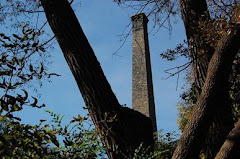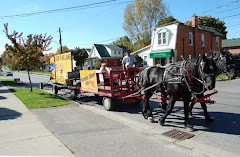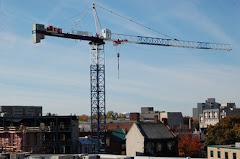This evening, things got heated - but not as heated as they were at the afternoon session apparently - at a town hall about the business case for a new main branch of the Guelph Public Library. The two meetings today were meant to update the public about the pending developments for the construction of the new main branch, but it frequently descended into an inquisition as to whether or not the City and Library are being open and transparent enough about the process.
The meeting was led by Library CEO Steve Kraft, and KMPG Director of Public Sector Advisory Bruce Peever, who's consulting on the business case. The meeting started straightforward enough with an overview of how they've developed the case so far. This document will go before council at next month's planning meeting, and if all that goes well, the library board will seek $1.9 million to hire an architect and begin a conceptual design sometime before the end of 2018.
After that, the new building will be designed and approved over a 12 to 14 month period. The project will then be tendered and awarded, and then the shovels will go into the ground sometime around 2020 with a completed library done by 2023. That is if we all keep our fingers crossed.
What didn't go according to plan though was the ruckus. As Kraft and Peever tried to draw the attention of the people gathered to the multi-step process of developing the business case, some in the crowd want to be heard on a matter of engagement. A handout was passed around with Guelph's Community Engagement guidelines, and it was suggested that this course to get feedback. on the part of the library board, was not following that process.
Some in the crowd noted that it seemed to them that important decisions were being made in order to make the business case, and that including the public now was pro forma with no opportunity for real input. Both Kraft and Peever assured that the process was still early, and that the business case was meant to bring to council an indication of the rough size of "the box" for the new library, and why it should spend money building that box. Conversations on what exactly will "go into that box" will come later.
Kraft and Peever also stated that a budget for the project is not part of the business case. When the business case comes back to council next month, it is merely a justification of expense, and a statement of commitment on the part of the library board that this is part of their strategic plan. The meeting got back on track, for a while anyway, when another person in crowd said that it was his feeling the meeting had been "hijacked".
So back to "the box", and the question of why we need a new downtown main branch of the library? Part two of the development of a business case was an examination of the current building. "The architect has gone through this building and identified some significant deficiencies," said Peever, who added that the current Norfolk St. location would need an extra 16,000 square feet so that it could brought to code.
"Is it worth, or could we even build, an additional 16,000 square feet for the collection?" Peever asked. "The answer is no."
The big issues with the building is its lack of compliance with the current Accessibility for Ontarians with Disabilities Act (AODA). The aisles between book shelves are too narrow, the shelves themselves are too high, the foyer is not big enough, and their are no accessible washrooms on the first floor. Under the AODA, the room for collections alone has to be vast because shelves have to be lower so that everyone can reach every book.
This is where guidelines set out by the Wisconsin Department of Public Instruction come in with a plan by Anders C. Dahlgren, the President of Library Planning Associates Inc., called Public Library Space Needs: A Planning Outline. Here, Dahlgren and his team calculated a "broad high-level footprint" for public libraries that can then be tailored and outfitted with the specific culture of the town or city that it's being built in. When you factor in the AODA's standard of eight books per square foot for collections, the room for 250,000 plus books, plus the requisite space for meeting rooms and "special needs" (which includes computers, tech, special collections, a cafe, et cetera), the new main branch is looking at approximately 87,000 square feet.
In other words, a new building that's almost three times the size of the current one.
These limited details would cause some friction later as some were concerned that the business case did not lay out a specific caveat for a 300-seat auditorium as part of the plan. The genial hosts of the town hall again reminded that this was still a matter to be determined. Carly Klassen, a member of the library board, added that the inclusion of an auditorium will be determined by future feedback a and needs assessment that will be done with the community after the business case is approved by council. As such, an auditorium included in the new library can't be confirmed, but it can't be excluded either.
Throwing a potential wrench into the plans for a 300-seat auditorium in a new downtown library is the fact that Guelph Jazz Festival founder Ajay Heble just received a $2.03 million grant from the Canada Foundation for Innovation for an auditorium for similar size on the campus of the University of Guelph.
Councillor James Gordon, who's the representative for council on the library board, mentioned his work with the Arts Platform, a grassroots endeavour to create more performing arts space downtown. According to him, the work done by the Platform showed the real need was for a multifunctional space that could be adapted for music, theatre, workshop, and other performance-based uses that seated just 120.
Perhaps inevitably, the meeting came around to recrimination about missed opportunities of the past. Board member Scott Butler was hearing none of it. "The past is the past. We can cry over spilled milk and unsigned bells all we want, but let’s move forward," he said. "We don’t give a damn about what happened in 2011, we’re interested in 2019. We’ve been complaining and talking about this for far too long."
Councillor Cathy Downer seemed to echo those remarks saying that the community has to make it clear to council that this is a priority, especially in an election year. "This project is closer than it's ever been since it was approved once before," she said referring to the proposal to purchase the old post office building on Wyndham in the early 2000s. "It's important that the public help us on council to keep moving this forward."
Gordon added to that saying there's a concern that the momentum being felt right now might be lost post-election if the public doesn't keep a new library front and centre. "There's pressure, and mixed messages around the horseshoe," he said. "You have to be clear to councillors that we want to build that library of tomorrow and not bow to political pressure to build the library of yesterday."
There was some exception to the onus being put on the people though. "Council has set the agenda," said one angry man, "the fact that it will collide with an election is council's fault, not the public's."
Having said that though, there's still some practical stuff in the way. Deputy Chief Administrative Officer for Infrastructure, Development and Enterprise Scott Stewart was on hand to talk about the nitty gritty like infrastructure improvements to Wyndham Street North, which will have to be done in advance of any redevelopment of on Baker Street. Also imperative is the soon to be constructed parkade on Wilson Street, which council approved last summer.
In the meantime, the City of Guelph is collecting "pre-qualification" statements of interest from local contractors, and Stewart said about 26 have submitted so far when it comes to the proposed redevelopment of Baker Street. This first phase closes on March 20, with the next phase beginning on May 31.
City council will meet to approve the business case for the new library on February 13.




















No comments:
Post a Comment